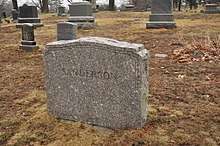Mildred Sanderson
Mildred Sanderson (1889–1914) was an American mathematician, best known for her mathematical theorem concerning modular invariants.[1][2]
Mildred Leonora Sanderson | |
|---|---|
.jpg) | |
| Born | May 12, 1889 |
| Died | October 15, 1914 (aged 25) |
| Resting place | Mount Feake Cemetery, Waltham |
| Scientific career | |
| Fields | Mathematics |
| Thesis | Formal modular invariants with application to binary modular covariants (1913) |
| Doctoral advisor | Leonard Eugene Dickson |
Life
Sanderson was born in Waltham, Massachusetts, in 1889 and was the valedictorian of her class at the Waltham High School.[1] She graduated from Mount Holyoke College in 1910, winning Senior Honors in Mathematics.[1] She obtained her Ph.D degree from the University of Chicago in 1913,[3] publishing the thesis (Sanderson 1913) in which she set forth her mathematical theorem. She was Leonard Eugene Dickson's first female doctoral student.[1][3]
After completing her Ph.D., Sanderson briefly taught at the University of Wisconsin before her untimely death in 1914 due to tuberculosis.[1][4]
Sanderson's theorem

Sanderson's theorem (Sanderson 1913, p.490) states: "To any modular invariant of a system of forms under any group of linear transformations with coefficients in the field , there corresponds a formal invariant under such that for all sets of values in the field of the coefficients of the system of forms."
Recognition
Leonard Eugene Dickson (she was his first female doctoral student[1][3]) wrote of her thesis, "This paper is a highly important contribution to this field of work; its importance lies partly in the fact that it establishes a correspondence between modular and formal invariants. Her main theorem has already been frequently quoted on account of its fundamental character. Her proof is a remarkable piece of mathematics."[1]
Eric Temple Bell wrote, "Miss Sanderson's single contribution (1913) to modular invariants has been rated by competent judges as one of the classics of the subject."[1]
A Mildred L. Sanderson prize for excellence in mathematics was established in her honor in 1939 at Mount Holyoke College.[4]
She is mentioned in the 2008 book Pioneering women in American mathematics: the pre-1940 PhD's, by Judy Green and Jeanne LaDuke.[4]
References
- "Mildred Leonora Sanderson". www.agnesscott.edu. Retrieved 2018-03-14.
- Rutherford (2007, p.39)
- Mildred Sanderson at the Mathematics Genealogy Project
- Green, Judy; LaDuke, Jeanne (2008). Pioneering Women in American Mathematics — The Pre-1940 PhD's. History of Mathematics. 34 (1st ed.). American Mathematical Society, The London Mathematical Society. ISBN 978-0-8218-4376-5. Biography on p.542-543 of the Supplementary Material at AMS
- Rutherford, Daniel Edwin (2007) [1932], Modular invariants, Cambridge Tracts in Mathematics and Mathematical Physics, No. 27, Ramsay Press, ISBN 978-1-4067-3850-6, MR 0186665
- Sanderson, Mildred (1913), "Formal Modular Invariants with Application to Binary Modular Covariants", Transactions of the American Mathematical Society, Providence, R.I.: American Mathematical Society, 14 (4): 489–500, doi:10.2307/1988702, ISSN 0002-9947, JSTOR 1988702